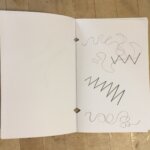Overview
In these lessons, students will learn how to make their own sketchbooks, observe other artists’ sketchbooks, and explore their own ideas through drawing and collecting in their sketchbooks.
Lessons
Materials and Tools
- 5 sheets of paper or construction paper
- About 20 inches of string (or yarn, shoelace, ribbon)
- Scissors
- Pencil (crayon, marker, other drawing tool)
Objectives
- Students will learn how to make a sketchbook.
- Students will learn what materials are needed for a sketchbook.
- Students will learn why and how artists use sketchbooks.
Student Outcomes
Students will be able to make their own sketchbook. They will explore different ways to use a sketchbook, including drawing lines and drawing from observation.
Students will understand that:
- A sketchbook can be used in many ways.
- Artists use sketchbooks to draw what they see, feel, and think.
- Students can make their own sketchbook with materials found at home.
- Students will understand how different artists use their sketchbooks.
Students will be able to:
- Fold, bind and create a sketchbook with paper and string.
- Explore ways to use their personal sketchbooks including drawing and responding to their own thoughts, ideas, and observations.
- Observe and reflect on multiple artists’ sketchbooks.
Resources
Adaptations
For Students with Disabilities
- Chunking information into step-by-step instructions.
- Provide alternate ways to work with materials (hold pencil a different way) or adaptive drawing tools.
For Multilingual Learners
- Use fingers and hand motions to create lines and repeat their names out loud.
- Demonstrate tracing hand lines on your own hand before trying on paper.
Extensions
K-2nd Grade
- Draw a house, tower or building that you would like to build with blocks.
- Look outside your window and draw what you see.
- Draw an imaginary animal.
- Collaborative sketchbook: students can make individual pages with or without themes. Teachers may join these pages with a brass fastener or ring. Some theme ideas can be: self-portraits, textures, or colors. This collaborative book could be on display for kids to look at during independent reading.
- Free draw on one page of your sketchbook.
3rd-5th Grade
- Self-portrait
- Look outside your window and draw what you see. Are there buildings? Are there people? What colors are there? What details do you see?
- Let’s do some close looking – find and draw an object in your home! Try a toothbrush, a mug, a plant or a shoe!
- Draw an imaginary animal! Where does it live? What is its habitat? How does it move in the world—does it walk or does it fly? Does it have eyes? If so, how many? What does it eat?
- We can collect and save things in our sketchbooks! What could you glue onto your sketchbook pages? Can you find any interesting paper scraps or labels in your home? Maybe a candy wrapper or a label on a food can? What about something in the mail? Does it have a shape or color you like? We can collect these things and glue them into our sketchbooks.
Use Sketchbooks to Connect to Curriculum
Science
- Students can use observational drawing to record and study the natural world.
- Students can create drawings of different environments and/or habitats.
- Students can record their experimentations with color mixing.
Social Studies
- Students can imagine and sketch what life might be like in different places and points in time.
- Students can visit The Met’s Timeline of Art History to find works of art from any period in history and sketch what they discover.
Math
- Students can explore concepts of pattern, shape, and angle.
- Students can create drawings using proportion, scale, and volume.
- Students can explore perspective in their sketchbooks.
Language Arts
- Students can use sketchbooks to respond to or illustrate their reading in words and images.
- Students can develop their own characters and narratives in their sketchbooks.
- Students can create scenes and settings in their sketchbooks.
- Students can add details to depictions of scenes, settings, characters, emotions, seasons, etc.
- Students can look at narrative works of art and sketch what they think came before and after the moment in the artwork.
- Sketchbooks can be used as journals for students to draw and write about their experiences, ideas, and emotions.
New York Teaching & Learning in Visual Arts Standards
Art Making: Drawing
Literacy in the Arts
- Looking at and Discussing Art
- Developing Visual Arts Vocabulary
Making Connections
- Observing and Interpreting the World
Community and Cultural Resources
- Online Resources and Libraries
Careers and Lifelong Learning
- Awareness of Careers in Visual Arts
NYS Learning Standards for the Arts
Artistic Process: Creating
Anchor Standards:
- Anchor Standard 1: Generate and conceptualize artistic ideas and work
- Anchor Standard 2: Organize and develop artistic ideas and work
Artistic Process: Presenting
Anchor Standards:
- Anchor Standard 4: Select, analyze, and interpret artistic work for presentation
Artistic Process: Responding
Anchor Standards:
- Anchor Standard 8: Interpret meaning in artistic work
Artistic Process: Connecting
Anchor Standards:
- Anchor Standard 10: Relate and synthesize knowledge and personal experiences to inspire and inform artistic work
Credits
Written By:
Kate Field, Artist Instructor
Judy Hoffman, Artist Instructor
Copyright © 2023 Studio in a School NYC LLC



